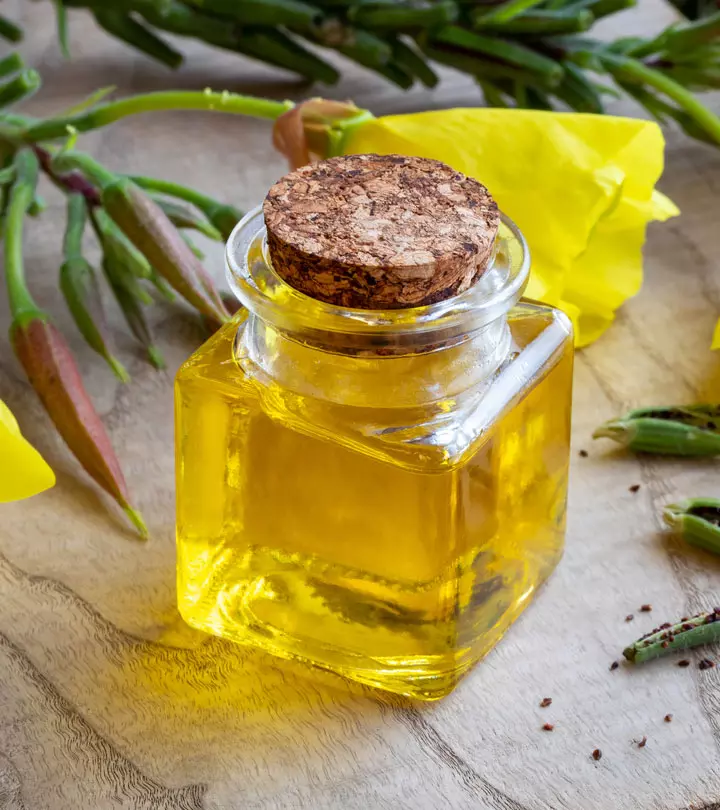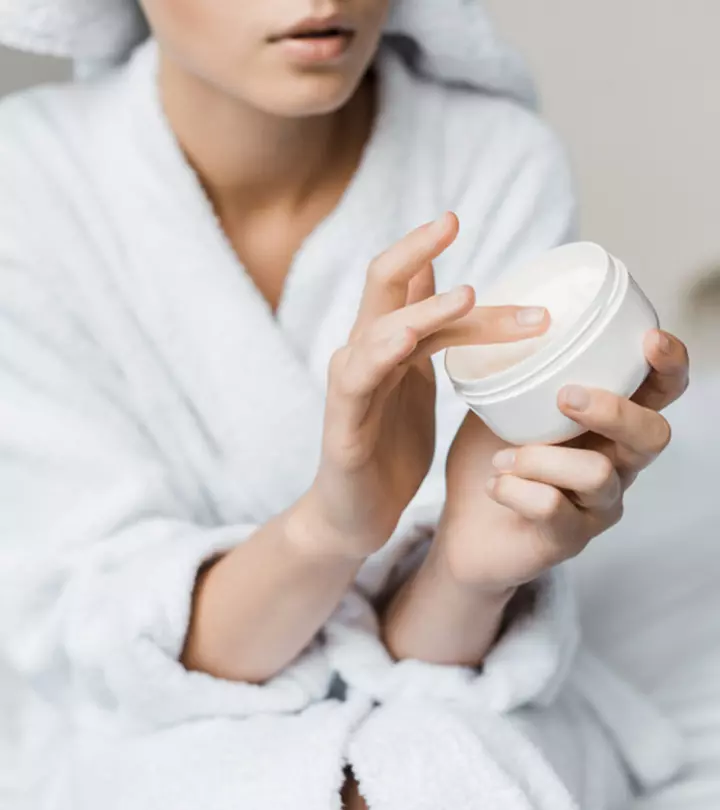Daily Skin Care Routine For Oily Skin: Dos And Don’ts
Practical solutions aimed at helping you keep all your oily skin woes at bay.

Image: Shutterstock
Skin care routine for oily skin has to be spot-on to look your best and have a shine-free T-zone. Oily skin happens due to excess sebum production, making the skin prone to frequent acne breakouts and hyperpigmentationi A harmless skin condition where patches of skin become darker than the surrounding areas due to excess melanin production. . So, people with this skin type usually carry a no-sebum mineral powder and/or some blotting paper and stay away from liquid and cream foundations. If you are looking for a way out of these skin conditions, this article is for you. It will help you design a skin care routine for managing your oily skin better. Read on!
In This Article
Oily Skin And Its Causes

Our skin has sebaceous glands that produce sebum (or natural oils) to moisturize it and protect its lipid barrier. However, oily skin produces excess sebum, which leads to shiny skin, greasiness, enlarged and clogged pores, acne, blackheads, and breakouts. Several factors can contribute to this and may aggravate oily skin issues.
Hormonal imbalance is linked to increased sebaceous gland activity. Hormones like androgen and estrogen may affect the sebocytes (sebum-producing cells), increase their activity, and lead to acne (1).
Several factors may cause hormonal imbalance and oily skin. They include:
- Thyroid issues
- Menstruation
- Menopause
- High stress levels
Other factors that may contribute to oily skin include:
- Environmental factors (humidity, UV exposure, and pollution)
- Excessive cleansing
- Drugs and medications
- Poor diet and nutrition
If you have oily skin, all these issues can influence sebum production and add to the existing issues.
The tell-tale signs of oily skin include:
- Excess shiny skin
- Visible pores
- Greasy skin
- Blackheads and whiteheads, especially around the nose
- Rough skin texture
- Frequent breakouts and blemishes
- Skin looks shiny shortly after cleansing
- Makeup slides off the face (even after using mattifying primer and setting powder)
 Quick Tip
Quick TipIf you can relate to all the points discussed above, we understand your pain. However, a good skin care routine can help you minimize the oiliness and manage the associated issues. The first step is to choose the right product containing the right ingredient.
Key Takeaways
- The excess sebum production in oily skin can cause acne, breakouts, and greasiness.
- Skin care products with retinol, salicylic acid, and hyaluronic acid may help minimize the oiliness.
- Avoid using products with ingredients like coconut oil or beeswax.
- Keeping blotting papers handy, using makeup products made for oily skin type, and avoiding touching your face frequently may help in managing oily skin.
8 Must-Have Ingredients For Oily Skin
1. Retinol
Talk of skin care, and one of the first ingredients that comes to mind is retinol. This ingredient (2):
- Reduces pore visibility
- Repairs photodamage
- Helps in acne prevention
It also minimizes fine lines and wrinkles and reduces hyperpigmentation.
However, retinol can irritate the skin, so use it sparingly and start with a low concentration. Retinol is best used in your PM routine. Strict sun protection must be followed if it is used in your AM routine. Make sure you are using sunscreen during the day to prevent sun damage as retinol can increase photosensitivity.
2. Salicylic Acid
Salicylic acid
is an absolute must-have ingredient for oily skin. This keratolytici The effect that breaks the outer layer of the skin to prevent or treat dry, scaly, rough, or itchy skin caused due to skin issues. agent disrupts the cellular junctions of the skin, promoting its natural exfoliation process, and helping to keep the pores clean. Salicylic acid is one of the main ingredients used to treat acne inflammation (3). Get cleansers with 2% (maximum strength) salicylic acid to wash your face twice a day.
3. Hyaluronic Acid

If you think oily skin does not need moisturization, you are wrong. Lack of moisture can trigger your skin to produce more sebum to compensate for the moisture loss. Hyaluronic acid is lightweight and gentle, provides hydration, and can significantly help with sebum regulation (4).
It is available as sodium hyaluronate in serums and creams. It is the sodium salt of hyaluronic acid that penetrates the skin easily and provides better moisturization.
4. Niacinamide
Skin care enthusiasts absolutely adore this cosmeceuticali A product or ingredient that serves the purpose of cosmetics and medicine and primarily belongs to the skin care category. . Niacinamide (also called nicotinamidei A water-soluble form of vitamin B present in food that helps treat skin disorders and niacin deficiencies. ) is a potent antioxidant with the following benefits (5), (6):
A study conducted on the Japanese and Caucasian population stated that using 2% niacinamide reduces the sebum levels on the skin . Niacinamide (vitamin B3) performs the following functions when used in skin care products:
- Reinforces the skin barrier
- Increases the skin cell turnover rate
- Minimizes hyperpigmentationi A harmless skin condition where patches of skin become darker than the surrounding areas due to excess melanin production.
- Increases the skin elasticity
- Reduces the skin pore size and excess sebum production
5. Alpha Arbutin
Alpha arbutin is your holy grail if you have skin issues like hyperpigmentationi A harmless skin condition where patches of skin become darker than the surrounding areas due to excess melanin production. , blemishes, and acne marks. This skin lightening agent inhibits tyrosinase activity (an enzyme that supports melanin synthesis), reduces melanin concentration, and helps in blemish control (7). But always remember to treat your acne first before treating acne marks.
6. Clay
If you are more into natural remedies, mineral-rich clays can help you get rid of excess sebum. Clays like bentonite and kaolin clays, fuller’s earth, and rhassoul clay help in exfoliating the skin to remove dead skin cells, reducing sebum production (8). However, follow up with a moisturizer to prevent excess dryness.
7. Alpha Hydroxy Acids
Oily skin loves facial peels. Alpha hydroxy acids like glycolic, lactic, and mandelic acids are commonly used to manage acne, scars, melasmai A skin pigmentation disorder characterized by brown or gray discolored patches on the sun-exposed areas of the skin. , hyperpigmentationi A harmless skin condition where patches of skin become darker than the surrounding areas due to excess melanin production. , age spots, and skin roughness (9).
While you can opt for in-clinic treatments, you can also buy OTC facial peels available at different strengths. These peels can improve your skin texture and also minimize the appearance of pores. However, if you haven’t used AHA-BHA peels, it is better to start from the lowest concentration and let your skin get accustomed to it before trying strong products.
8. Squalene
Squalene is a natural compound found in the skin’s sebum that helps regulate excess oil production without blocking the skin pores. It possesses anti-inflammatory properties that reduce swelling and redness in acne-prone skin and skin conditions like eczema (10). Its light texture hydrates the skin without giving it a heavy, greasy feeling. This way, squalene is considered ideal for oily skin. Squalene is also known for its antioxidant properties that help protect the skin from environmental damage and free radicals and help improve one’s overall skin health (11). If you have not included squalene in your beauty regimen before, consider starting with gentler formulas to avoid any irritation.
Besides these ingredients, you can also look for products containing tea tree oil, ceramides, and peptides to nourish your skin and minimize acne. However, there are few ingredients that people with oily skin must avoid at all costs.
Ingredients To Avoid If You Have Oily Skin

If you have oily skin, avoid the ingredients that fall under these categories:
Products containing vegetable oils with high fatty acids, like:
- Coconut oil
- Sunflower oil
- Camellia oil
- Hazelnut oil
Occlusive ingredients, like:
- Beeswax
- Lanolin
- Paraffin
Once you have gathered your products, it is time to set a daily skin care routine. We all follow a basic cleansing-toning-moisturizing (CTM) routine. However, you can add a few more steps to the basic oily skin care routine to provide extra nourishment to your skin.
Best Skin Care Routine For Oily Skin
Morning Skin Care Routine For Oily Skin
Step 1: Cleanse
Wash your face with a mild and gentle cleanser to clean all the dirt and sebum that your skin might have gathered overnight.
Step 2: Exfoliate
Follow this step only once a week. You can use a physical or a chemical exfoliator to slough away the dead skin cells and smoothen the texture. Invest in products formulated with salicylic acid or glycolic acid that can easily remove dead skin cells from your skin and unclog pores, thereby preventing acne breakouts and promoting overall clear skin.
Step 3: Tone
Do not skip this step. Toner helps prep your skin to absorb all the goodness of the skin care products. It also cleans the residue that remains on the face after cleansing.
Toner helps:
- Normalize the skin pH
- Keep your skin hydrated
- Helps in pore minimization
Avoid alcohol-based toners as they can strip the natural oils off your skin.
Step 4: Serum
After the initial cleansing and toning, apply a serum to address specific skin issues. You can use serums that contain vitamins C and E, hyaluronic acid, niacinamide, alpha arbutin, and other ingredients to address skin issues like acne, hyperpigmentationi A harmless skin condition where patches of skin become darker than the surrounding areas due to excess melanin production. , and enlarged pores.
Step 5: Moisturizing
For oily skin, use water-based gel moisturizers to lock in moisture, maintain your skin’s hydration level, and prevent overproduction of sebum. The right way to moisturize oily skin is by applying moisturizer on the cheeks first, using gentle, outward strokes. Then, use smooth strokes around your eyes to apply the moisturizer. Finish off by applying moisturizer on the neck and forehead in gentle upward strokes.
Step 6: Eye Cream
The skin under your eyes is delicate and prone to damage. It does have oil glands and dries out easily, especially if you use acne creams that cause dryness. Invest in a good eye cream that maintains the hydration in the skin under your eyes and addresses specific concerns like dark circles, puffiness, or wrinkles.
Step 7: Sunscreen
Sunscreen is essential if you head outdoors during the day. Pick a gel-based sunscreen for oily skin. Ingredients like silicone in your sunscreen will offer a mattifying effect while keeping your skin relatively oil-free. Ensure that it has at least SPF 30 and PA+++ rating.
A study conducted on more than 1000 Americans found that 82% of them thought sunscreen usage was more important now than five years back. It was further noted that 67% wrongly thought that SPF 30 sunscreens offered double the protection as SPF 15 and 65% often forgot to reapply sunscreen.
Evening Routine For Oily Skin

Step 1: Double Cleanse
Use an oil-based cleanser, a cleansing balm, or micellar water to lift the makeup, dirt, and residue, and then use a mild and gentle cleanser to wash your face.
Step 2: Detox With A Clay Mask
Use a clay mask once or twice a week to rejuvenate and exfoliate your skin. You can invest in a detoxifying clay mask or go the DIY way. It removes the dirt and oil from your facial skin and improves the skin texture. Avoid exfoliating often if you are using a clay mask regularly as doing both can damage your skin barrier.
Step 3: Toner
After cleansing (or removing your mask), use a toner. This is important to calm your skin and remove any remaining dirt or oil.
Step 4: Use Retinol-Based Serum
This is an important part of your nighttime skin care routine. As your skin repairs itself during the night, using retinol can help reduce wrinkles and fine lines and speed up the healing process. Since retinol makes your skin photosensitive, use it at night. Initially, use it just 1-2 times a week. You can start using it more frequently once your skin gets used to it.
Step 5: Other Treatment
You can apply spot treatments and other active ingredients, like niacinamide and hyaluronic acid, for an additional boost of nutrients.
Step 6: Eye cream
Using an eye cream is important at night as it helps the area under your eyes stay nourished and smooth while you get a good night’s sleep.
Step 7: Moisturizer
Use a light moisturizer before you retire for the day. Avoid heavy oil-based night creams as they can clog your pores.
Apart from following a daily morning and evening skin care routine, here are some more handy tips and a list of dos and don’ts for managing oily skin.
Other Tips To Manage Oily Skin
- Blotting Papers Are True Saviors
Blotting papers are your secret weapons to beat the mid-afternoon grease and shine. These papers are easy to carry and absorb the excess oil on your face.
- Apply A Facial Mist Throughout The Day
Carry a facial mist wherever you go to freshen up your skin throughout the day. It helps remove dirt and unclog your pores, making you feel fresh instantly. For better results, use a facial mist with hydrating ingredients like glycerin, hyaluronic acid, or soothing ingredients like Centella asiatica.
- Use Appropriate Makeup Products
Not all products suit oily skin. Use an oil-free and mineral-based foundation with a matte finish. It helps prevent shine and stays on for longer hours.
- Avoid Touching Your Face Frequently
Your hands and fingers are not always clean. Frequently touching your face can transfer dirt and bacteria to your skin that may clog the pores.
Dos And Don’ts For Oily Skin

Dos
- Wash your face twice a day, once in the morning and once at night.
- Use a clay mask weekly to deeply cleanse your skin, remove impurities, and prevent breakouts.
- Sunscreen is important and compulsory if you are heading outdoors.
- Always use makeup that suits your skin type.
- Clean your makeup brushes to prevent breakouts.
- Change your pillow cover frequently.
- Get 8 hours of sleep every day.
- Work out every day to improve blood circulation in the body, including your skin, and stay healthy.
- Always remove your makeup before going to bed at night.
Don’ts
- Avoid using petroleum or petrolatum-based products.
- Do not wash your face frequently or more than twice.
- Avoid alcohol-based toners.
- Never rub or scrub your face vigorously.
- Avoid smoking to maintain skin health.
 Quick Tip
Quick TipInfographic: Ingredients For Oily Skin
When it comes to managing oily skin, choosing the right ingredients and skin care products is key. While the article discusses all the ways to manage oily skin along with some dos and don’ts for skin care, we would like to highlight the ingredients you should use on this skin type. Check out the infographic below to know more about what ingredients to look for in products for oily skin.

Illustration: StyleCraze Design Team
Hormonal imbalance, environmental pollutants, poor diet, and medications contribute to oily and greasy skin. A few signs of oily skin include visible pores, whiteheads, blemishes, and rough skin texture. This is where the right and proper skincare for oily skin comes into play. The first step is choosing products with ingredients such as niacinamide, hyaluronic acid, or clay will reduce sebum production and provide proper hydration. Following a healthy and sustainable lifestyle and using the right skin care products can help you manage oily skin better and improve your overall skin texture and health.
Frequently Asked Questions
Is it suitable to use oil-based products on oily skin?
Overall, it is suggested to opt for water-based products for oily skin type but you may use certain oil-based products as well. Look for non-comedogenic oils like jojoba or squalene to prevent clogging.
Is vitamin C good for oily skin?
Yes, vitamin C is a powerful antioxidant that unclogs your pores, improves skin texture, and keeps your skin hydrated.
Is rose water good for oily skin?
Yes, you can use rosewater as a daily toner to unclog your pores and keep your skin nourished.
How can I prevent breakouts on oily skin?
Cleanse and moisturize your skin daily, frequently clean your makeup brushes and use makeup only when required, and use salicylic acid as part of your skincare routine.
How can I reduce the appearance of large pores on oily skin?
Exfoliate your face to properly clean the pores, and apply retinoids to keep the skin firm. A sunscreen is a must in case you’re stepping out into the sun.
Are there any lifestyle changes I can make to help manage my oily skin?
A proper skincare regimen as per your skin type, a healthy diet, and restricting oily foods can help you manage oily skin better.
Illustration: Daily Skin Care Routine For Oily Skin: Dos And Dont&039s

Image: Stable Diffusion/StyleCraze Design Team
Learn 5 easy skin care tips to manage oily skin at home. Check out this video to know more about how to keep your skin healthy and glowing.
References
Articles on StyleCraze are backed by verified information from peer-reviewed and academic research papers, reputed organizations, research institutions, and medical associations to ensure accuracy and relevance. Read our editorial policy to learn more.
- An update on the role of the sebaceous gland in the pathogenesis of acne
https://www.ncbi.nlm.nih.gov/pmc/articles/PMC3051853/ - Oily Skin: A review of Treatment Options
https://www.ncbi.nlm.nih.gov/pmc/articles/PMC5605215/ - A double-blind
placebo-controlled evaluation of a 2% salicylic acid cleanser for improvement of acne vulgaris - Hyaluronic Acid Decreases Lipid Synthesis in Sebaceous Glands
https://pubmed.ncbi.nlm.nih.gov/28163068/ - How Much Do We Really Know About Our Favorite Cosmeceutical Ingredients?
https://www.ncbi.nlm.nih.gov/pmc/articles/PMC2921764/ - The effect of 2% niacinamide on facial sebum production
https://pubmed.ncbi.nlm.nih.gov/16766489/ - Alpha Arbutin as a Skin Lightening Agent: A Review
https://www.researchgate.net/publication/350621514_Alpha_Arbutin_as_a_Skin_Lightening_Agent_A_Review - Characterization and Short-Term clinical study of clay facial mask
https://www.researchgate.net/publication/318508286_Characterization_and_Short-Term_clinical_study_of_clay_facial_mask - Dual Effects of Alpha-Hydroxy Acids on the Skin
https://www.ncbi.nlm.nih.gov/pmc/articles/PMC6017965/ - Current Insights into the Biological Action of Squalene
https://pubmed.ncbi.nlm.nih.gov/29883523/ - Biological and Pharmacological Activities of Squalene and Related Compounds: Potential Uses in Cosmetic Dermatology
https://www.ncbi.nlm.nih.gov/pmc/articles/PMC6253993/
Read full bio of Dr. Manasi Shirolikar
Read full bio of Ramona Sinha
Read full bio of Anjali Sayee
Read full bio of Shiboli Chakraborti




























Community Experiences
Join the conversation and become a part of our empowering community! Share your stories, experiences, and insights to connect with other beauty, lifestyle, and health enthusiasts.